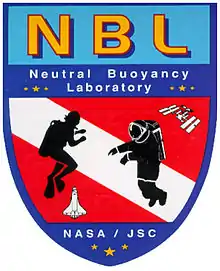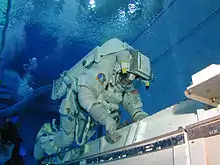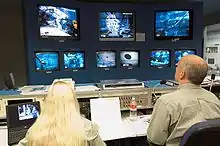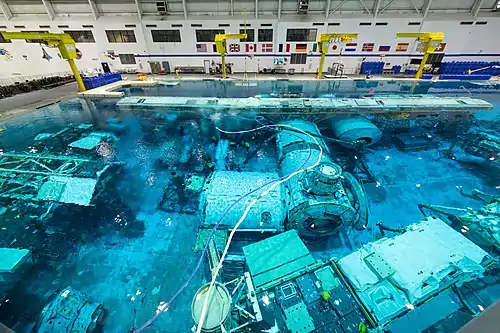Neutral Buoyancy Laboratory
The Neutral Buoyancy Laboratory (NBL) is an astronaut training facility and neutral buoyancy pool operated by NASA and located at the Sonny Carter Training Facility, near the Johnson Space Center in Houston, Texas.[2] The NBL's main feature is a large indoor pool of water,[3] in which astronauts may perform simulated EVA tasks in preparation for upcoming missions. Trainees wear suits designed to provide neutral buoyancy to simulate the microgravity that astronauts would experience during spaceflight.
 | |
 An astronaut training in the NBL | |
| Established | April 1995 (1995-April)[1] |
|---|---|
| Location | Houston, Texas, United States |
Operating agency | NASA |
| Website | dx12 |

History
In the late 1980s NASA began to consider replacing its previous neutral-buoyancy training facility, the Weightless Environment Training Facility (WETF). The WETF, located at Johnson Space Center, had been successfully used to train astronauts for numerous missions, but its pool was too small to hold useful mock-ups of space station components of the sorts intended for the mooted Space Station Freedom, or its successor, the International Space Station.
This new pool was going to be on Johnson Space Center property and was planned to be 72 meters (235 ft) by 41 meters (135 ft), with a depth of 18 meters (60 ft). To save money it was downsized and placed inside an existing structure.
NASA purchased the structure that now holds the NBL from McDonnell Douglas in the early 1990s and began refitting it as a neutral-buoyancy training center in 1995.[4]
Pool features
The diving tank is 202 feet (62 m) in length, 102 feet (31 m) wide, and 40 feet 6 inches (12.34 m) deep, and contains 6.2 million gallons (23.5 million litres) of water.[5][6] The NBL contains full-scale mock-ups of International Space Station (ISS) modules and payloads, as well as visiting vehicles such as the Japan Aerospace Exploration Agency (JAXA) HTV, the European Space Agency ATV, the SpaceX Dragon, and the Orbital Sciences Corporation Cygnus.[5] Full-scale mock-ups of equipment such as the Space Shuttle payload bay and Hubble Space Telescope have been removed, as they are no longer needed for training.

See also
- Neutral buoyancy pool – Pool of water in which neutral buoyancy is used to train astronauts
- Weightlessness – Absence of stress and strain resulting from externally applied mechanical contact-forces
- Reduced-gravity aircraft, also known as Vomit Comet – Fixed-wing aircraft that provides brief near-weightless environments
References
- "NBL Timeline". Neutral Buoyancy Laboratory. Archived from the original on 2 April 2015. Retrieved 20 March 2015.
- Strauss, S (July 2008). "Space medicine at the NASA-JSC, neutral buoyancy laboratory". Aviation, Space, and Environmental Medicine. 79 (7): 732–3. PMID 18619137.
- "Behind the scenes training". NASA. May 30, 2003. Retrieved March 22, 2011.
- Hutchinson, Lee (4 March 2013). "Swimming with spacemen: training for spacewalks at NASA's giant pool". Ars Technica. Retrieved 24 March 2015.
- Strauss S, Krog RL, Feiveson AH (May 2005). "Extravehicular mobility unit training and astronaut injuries". Aviat Space Environ Med. 76 (5): 469–74. PMID 15892545. Retrieved 2008-08-27.
- "NBL Characteristics". About the NBL. NASA. June 23, 2005. Archived from the original on June 26, 2007.
NASA facilities | |||||
|---|---|---|---|---|---|
| Primary 10 centers |
| ||||
| Other facilities | |||||
| Related | |||||
